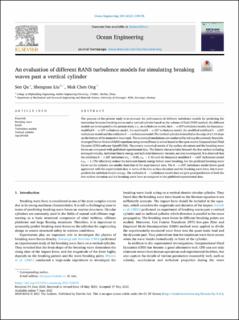| dc.contributor.author | Qu, Sen | |
| dc.contributor.author | Liu, Shengnan | |
| dc.contributor.author | Ong, Muk Chen | |
| dc.date.accessioned | 2023-02-09T14:32:06Z | |
| dc.date.available | 2023-02-09T14:32:06Z | |
| dc.date.created | 2022-01-20T14:06:39Z | |
| dc.date.issued | 2021 | |
| dc.identifier.citation | Qu, S., Liu, S., & Ong, M. C. (2021). An evaluation of different RANS turbulence models for simulating breaking waves past a vertical cylinder. Ocean Engineering, 234, 109195. | en_US |
| dc.identifier.issn | 0029-8018 | |
| dc.identifier.uri | https://hdl.handle.net/11250/3049820 | |
| dc.description.abstract | The purpose of the present study is to evaluate the performance of different turbulence models for predicting the interaction between breaking waves and a vertical cylinder based on the volume of fluid (VOF) method. Six different models are investigated in the present study, i.e., no turbulence model, the k − ω SST turbulence model, the buoyancymodified k − ω SST turbulence model, the stabilized k − ω SST turbulence model, the modified stabilized k − ωSST turbulence model and the realizable k − ε turbulence model. The vertical cylinder is installed at the edge of a 1:10 slope on the bottom of the numerical wave tank. The numerical simulations are conducted by solving the unsteady ReynoldsAveraged Navier-Stokes (RANS) equations using waves2Foam (a solver based on the open-source Computational Fluid Dynamic (CFD) software OpenFOAM). The present numerical results of the surface elevations and the breaking wave forces are compared with published experimental data. The kinetic characteristics beneath the free surface including averaged velocity, turbulent kinetic energy and turbulent kinematic viscosity are also investigated. It is observed that the stabilized k − ω SST turbulence (λ2 = 0.05, αβs = 1.36) and the buoyancy-modified k − ωSST turbulence model (αβs = 1.176) effectively reduce the turbulent kinetic energy before wave breaking, but the predicted breaking wave forces on the cylinder are smaller than that of the experimental data. The k − ω SST turbulence model shows good agreement with the experimental data in terms of the free surface elevation and the breaking wave force, but it overpredicts the turbulent kinetic energy. The realizable k − ε turbulence model does not give good predictions of both the free surface elevation and the breaking wave force as compared to the published experimental data. | en_US |
| dc.language.iso | eng | en_US |
| dc.publisher | Elsevier | en_US |
| dc.rights | Navngivelse 4.0 Internasjonal | * |
| dc.rights.uri | http://creativecommons.org/licenses/by/4.0/deed.no | * |
| dc.title | An evaluation of different RANS turbulence models for simulating breaking waves past a vertical cylinder | en_US |
| dc.type | Peer reviewed | en_US |
| dc.type | Journal article | en_US |
| dc.description.version | publishedVersion | en_US |
| dc.rights.holder | The authors | en_US |
| dc.subject.nsi | VDP::Teknologi: 500 | en_US |
| dc.source.pagenumber | 13 | en_US |
| dc.source.volume | 234 | en_US |
| dc.source.journal | Ocean Engineering | en_US |
| dc.identifier.doi | 10.1016/j.oceaneng.2021.109195 | |
| dc.identifier.cristin | 1986289 | |
| cristin.ispublished | true | |
| cristin.fulltext | original | |
| cristin.qualitycode | 1 | |

